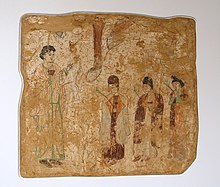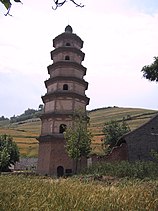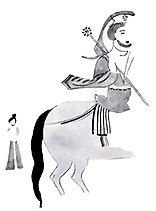Nestorianism
| Part of a series on |
| Christology |
|---|
Nestorianism is a term used in
After the condemnation, some supporters of Nestorius, who were followers of the
History

Nestorianism was condemned as
Nestorians held that the Council of Chalcedon proved the
Following the exodus to
Despite this initial Eastern expansion, the Nestorians' missionary success was eventually deterred.
Doctrine

Nestorianism is a radical form of
Nestorius's teachings became the root of controversy when he publicly challenged the long-used title Theotokos
He also advanced the image of Jesus as a warrior-king and rescuer of Israel over the traditional image of the Christus dolens.[21]
Nestorius' opponents found his teaching too close to the heresy of
Nestorian Schism
Nestorianism became a distinct sect following the
In 431 Theodosius called the Council of Ephesus. However, the council ultimately sided with Cyril, who held that the Christ contained two natures in one divine person (hypostasis, unity of subsistence), and that the Virgin Mary, conceiving and bearing this divine person, is truly called the Mother of God (Theotokos). The council accused Nestorius of heresy, and deposed him as patriarch.[24] Upon returning to his monastery in 436, he was banished to Upper Egypt. Nestorianism was officially anathematized, a ruling reiterated at the Council of Chalcedon in 451. However, a number of churches, particularly those associated with the School of Edessa, supported Nestorius – though not necessarily his doctrine – and broke with the churches of the West. Many of Nestorius' supporters relocated to the Sasanian Empire of Iran, home to a vibrant but persecuted Christian minority.[25] In Upper Egypt, Nestorius wrote his Book of Heraclides, responding to the two councils at Ephesus (431, 449).[18]
Christian denomination tree

- (Not shown are ante-Nicene, nontrinitarian, and restorationist denominations.)
Church of the East

The western provinces of the
In 486, the Metropolitan
Now firmly established in Persia, with centers in Nisibis, Ctesiphon, and Gundeshapur, and several metropoleis, the Persian Church began to branch out beyond the Sasanian Empire. However, through the sixth century, the church was frequently beset with internal strife and persecution by Zoroastrians. The infighting led to a schism, which lasted from 521 until around 539 when the issues were resolved. However, immediately afterward Roman-Persian conflict led to the persecution of the church by the Sassanid emperor Khosrow I; this ended in 545. The church survived these trials under the guidance of Patriarch Aba I, who had converted to Christianity from Zoroastrianism.[25]
The church emerged stronger after this period of ordeal, and increased missionary efforts farther afield. Missionaries established dioceses in the Arabian Peninsula and India (the Saint Thomas Christians). They made some advances in Egypt, despite the strong Miaphysite presence there.[26] Missionaries entered Central Asia and had significant success converting local Turkic tribes.
The Anuradhapura Cross discovered in Sri Lanka strongly suggests a strong presence of Nestorian Christianity in Sri Lanka during the 6th century AD according to Humphrey Codrington, who based his claim on a 6th-century manuscript, Christian Topography, that mentions of a community of Persian Christians who were known to reside in Taprobanê (the Ancient Greek name for Sri Lanka).[27][28][29]
Nestorian missionaries were firmly established in China during the early part of the
Following the
Assyrian Church of the East
In a 1996 article published in the
In a 2017 paper,
Several historical records suggest that the Assyrian Church of the East may have been in Sri Lanka between the mid-5th and 6th centuries.[27][28][29]
See also
- Arianism
- Aramaic New Testament
- Hypostatic union
- Nestorian Evangelion
- Nestorianism and the church in India
- Christian influences in Islam
References
- ^ Brock 2006, p. 177.
- ^ Baum & Winkler 2003, p. 4.
- ^ "Nestorianism". Oxford English Dictionary.
- ^ Chesnut 1978, p. 392–409.
- ^ a b Burgess 1989, p. 90, 229, 231.
- ^ a b c Meyendorff 1989.
- ^ Brock 1999, p. 281–298.
- ^ Brock 2006.
- ^ Baum & Winkler 2003, p. 3–5.
- ^ Baum & Winkler 2003, p. 4–5.
- ^ Brock 1996, p. 23–35.
- ^ Seleznyov 2010, p. 165–190.
- ^ ISBN 978-83-233-9555-3 – via Google Books.
- ^ Kleinbauer, W. Eugene (September 1972). "Zvartnots and the Origins of Christian Architecture in Armenia". The Art Bulletin. Vol. 54, no. 3. p. 261.
- ISBN 978-1-60833-146-8 – via Google Books.
- ^ Hogan. Dissent from the Creed. pp. 123–125.
- ^ Martin Lembke, lecture in the course "Meetings with the World's Religions", Centre for Theology and Religious Studies, Lund University, Spring Term 2010.
- ^ a b Hodgson & Driver 1925.
- ^ . Retrieved 2019-10-22.
- ISBN 978-1-85538-417-0.
- S2CID 171352591. Retrieved September 7, 2022.
- ^ Bentley, Jerry (1993). Old World Encounters: Cross-Cultural Contacts and Exchanges in Pre-Modern Times. New York: Oxford University Press. p. 105.
- ^ a b "Nestorius". Encyclopædia Britannica. Retrieved January 29, 2010.
- ^ "Cyril of Alexandria, Third Epistle to Nestorius, with 'Twelve Anathemas'". Monachos.net. Archived from the original on July 4, 2008.
- ^ a b c "Nestorianism". Encyclopædia Britannica. Retrieved January 28, 2010.
- ISBN 978-0-664-25650-0 – via Google Books.
- ^ a b "Mar Aprem Metropolitan Visits Ancient Anuradhapura Cross in Official Trip to Sri Lanka". Assyrian Church News. Archived from the original on 2015-02-26. Retrieved 6 August 2013.
- ^ a b Weerakoon, Rajitha (June 26, 2011). "Did Christianity exist in ancient Sri Lanka?". Sunday Times. Retrieved 2 August 2021.
- ^ a b "Main interest". Daily News. 22 April 2011. Archived from the original on 2015-03-29. Retrieved 2 August 2021.
- ISBN 1-56975-522-1 – via Google Books.
- ^ "Common Christological Declaration between the Catholic Church and the Assyrian Church of the East". Retrieved 8 February 2020.
- ^ "The Assyrian Church of the East: A Panoramic View of a Glorious History- Mar Awa Royel". Church of Beth Kokheh Journal. 2017-10-04. Retrieved 2019-10-25.
Sources
- Badger, George Percy (1852). The Nestorians and Their Rituals. Vol. 1. London: Joseph Masters – via Google Books.
- ISBN 9780790544823 – via Google Books.
- ISBN 9781134430192 – via Google Books.
- ISBN 9781107432987 – via Google Books.
- .
- ISBN 9780815330714 – via Google Books.
- ISBN 9780754659082 – via Google Books.
- Burgess, Stanley M. (1989). The Holy Spirit: Eastern Christian Traditions. Peabody, Mass.: Hendrickson Publishers. ISBN 9780913573815 – via Google Books.
- Chabot, Jean-Baptiste (1902). Synodicon orientale ou recueil de synodes nestoriens [Eastern Synodicon or Compendium of Nestorian Synods] (PDF) (in French). Paris: Imprimerie Nationale.
- Chesnut, Roberta C. (1978). "The Two Prosopa in Nestorius' Bazaar of Heracleides". The Journal of Theological Studies. 29 (29): 392–409. JSTOR 23958267.
- Hill, Henry, ed. (1988). Light from the East: A Symposium on the Oriental Orthodox and Assyrian Churches. Toronto: Anglican Book Centre. ISBN 9780919891906 – via Google Books.
- ISBN 9781725202399 – via Google Books.
- Jugie, Martin (1935). "L'ecclésiologie des Nestoriens" [The ecclesiology of the Nestorians] (PDF). Échos d'Orient (in French). 34 (177): 5–25. .
- Kuhn, Michael F. (2019). God is One: A Christian Defence of Divine Unity in the Muslim Golden Age. Carlisle: Langham Publishing. ISBN 9781783685776 – via Google Books.
- ISBN 9780881410563 – via Google Books.
- Reinink, Gerrit J. (2009). "Tradition and the Formation of the 'Nestorian' Identity in Sixth- to Seventh-Century Iraq". Church History and Religious Culture. 89 (1–3): 217–250. JSTOR 23932289.
- Rossabi, Morris (1992). Voyager from Xanadu: Rabban Sauma and the first journey from China to the West. ISBN 4770016506.
- Seleznyov, Nikolai N. (2010). "Nestorius of Constantinople: Condemnation, Suppression, Veneration: With special reference to the role of his name in East-Syriac Christianity". Journal of Eastern Christian Studies. 62 (3–4): 165–190.
- Stewart, John (1928). Nestorian missionary enterprise, the story of a church on fire. Edinburgh: T. & T. Clark.
- ISBN 9780837080789.
- Wilmshurst, David (2000). The Ecclesiastical Organisation of the Church of the East, 1318–1913. Louvain: Peeters Publishers. ISBN 9789042908765.
- Wilmshurst, David (2011). The martyred Church: A History of the Church of the East. London: East & West Publishing Limited. ISBN 9781907318047.
- Luise Abramowski, "Der Bischof von Seleukia-Ktesiphon als Katholikos und Patriarch der Kirche des Ostens," in Dmitrij Bumazhnov u. Hans R. Seeliger (hg), Syrien im 1.–7. Jahrhundert nach Christus. Akten der 1. Tübinger Tagung zum Christlichen Orient (15.–16. Juni 2007). (Tübingen, Mohr Siebeck, 2011) (Studien und Texte zu Antike und Christentum / Studies and Texts in Antiquity and Christianity, 62)
- Leonard, Pinto (2013). "A Brief History of Christianity In Sri Lanka".
External links
- "Unofficial Web Site of the 'Church of the East'". Nestorian.org.
- Lieu, Sam; Parry, Ken. "Manichaean and (Nestorian) Christian Remains in Zayton (Quanzhou, South China)". Macquarie University. Archived from the original on July 19, 2008. Retrieved January 24, 2010.
- Dickens, Mark (1999). "The Church of the East". Oxus Communications. Archived from the original on May 14, 2011. Retrieved February 6, 2010.
- "Nestorius and Nestorianism". The Catholic Encyclopedia.



